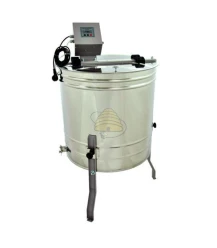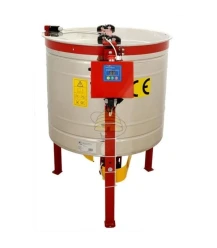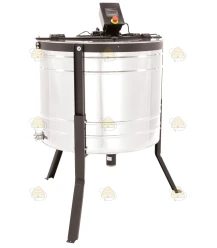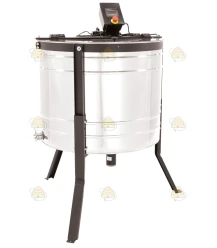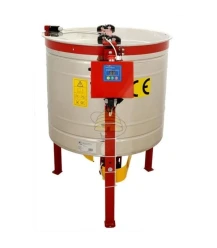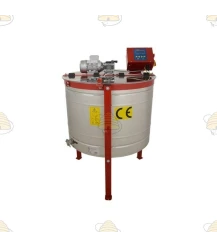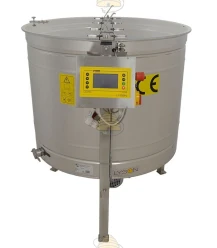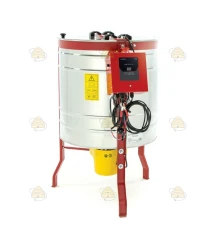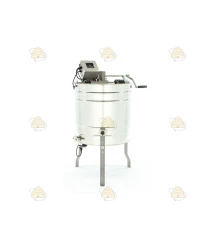Radial honey extractors
A radial honey extractor is an excellent choice for beekeepers who want to maximize efficiency in their extraction process. Thanks to the design of a radial honey extractor, you can extract honey from a large number of frames at the same time. While the electric honey extractor spins, you can continue uncapping frames or take care of other tasks in the apiary. This not only saves time but also makes the process less labor-intensive.
-
800mm radial & cassette honey extractor (Easy)
€ 3.175,95 In stock and available for immediate delivery.This Easy radial & cassette honey extractor, 800 mm, is a sturdy and easy-to-use entry-level model. The honey extractor can be used as a radial honey extractor but also as a cassette honey extractor. This can be done easily by rotating the hive frames in the drum. As a radial honey extractor it holds up to 12 German Normal / Dutch simplex honey super...View more -
600 mm 20-frame radial honey extractor (Easy)
€ 1.354,95 In stock and available for immediate delivery.This Easy radial honey extractor of 600 mm is a robust, easy-to-use entry-level model. The honey extractor holds 20 simplex honey super hive frames, Dadant ½ with a height of 145 mm, or 20 Dadant ½ frames with a height of 160 mm. The extractor is made of acid-resistant stainless steel. The side walls are made of 0.6 mm thick steel. The drum has a 5/4...View more -
720 mm 30-frame radial honey extractor (Easy)
€ 1.959,95 In stock and available for immediate delivery.This easy radial honey extractor, 720 mm, is a robust, easy-to-use entry-level model. The honey extractor holds 30 simplex honey super hive frames or 18 brood box hive frames, simplex, German Normal, Langstroth or Dadant. The extractor is made of acid-resistant stainless steel. The side walls are 0.6 mm thick steel. The drum has a 6/4 inch honey gate. The...View more -
720 mm multifunctional radial honey extractor (Easy)
€ 1.750,95 In StockHigh-quality 720 mm versatile radial honey extractor for different types of frames. This honey extractor fits 18 Langstroth or Zander frames, 30 Dadant honey super frames, or 18 German Normal (DNM) frames. Harvest honey efficiently and reliably. The stainless steel drum and powder-coated components ensure long-lasting performance. The safety lock prevents...View more -
800 mm multifunctional radial honey extractor (Easy)
€ 1.853,95 In StockHigh-quality 800 mm multifunctional radial honey extractor for various frame types. This honey extractor fits 30 Langstroth or Zander frames, 30 Dadant honey super frames, or 30 German Normal frames. Harvest honey efficiently and reliably with this extractor. You’ll enjoy it for years thanks to the stainless steel drum and powder-coated parts. The safety...View more -
900 mm multifunctional radial honey extractor (Easy)
€ 1.905,95 In StockHigh-quality 900 mm multifunctional radial honey extractor for different types of hive frames. This honey extractor is suitable for 42 Langstroth or Zander hive frames, 48 Dadant honey super frames / 24 Dadant brood box frames, or 42 German Normal frames. With this honey extractor you harvest honey efficiently and reliably. You will enjoy this honey...View more -
800 mm 30-frame radial honey extractor (Easy)
€ 2.011,95 Out of stockOut of stockThis Easy radial extractor of 800 mm is a sturdy and simple to operate entry-level model. The honey extractor accommodates 30 honey super frames or 18 brood box frames in Simplex, German Normal, Langstroth or Dadant size. The extractor is made of acid-resistant stainless steel. The side walls are 0.6 mm thick steel. The drum has a 6/4 inch gate valve. The...View more -
900 mm 42-frame radial honey extractor (Deluxe)
€ 2.587,95 Out of stockOut of stockThis Deluxe 900 mm radial honey extractor offers ample capacity and many features. The honey extractor holds 42 simplex honey super hive frames or 24 brood box hive frames, German normal, Langstroth or Dadant. The extractor is made of acid-resistant stainless steel. The side walls are made from 0.6 mm thick steel. The drum has a 6/4 inch honey gate. The...View more -
800 mm 30-frame radial honey extractor (Premium)
€ 3.586,95 This product is ordered, delivery time is approximately 14 days.800 mm stainless steel 30-frame radial honey extractor (Premium). This honey extractor operates via a fully automatic control system and is driven by a bottom-mounted drive. The extractor is made entirely of stainless steel and features transparent lids of thick acrylic. It holds, for example, 30 Dadant US honey super frames or 30 Simplex honey super...View more -
900 mm 42-frame radial honey extractor (Premium)
€ 3.792,95 This product is ordered, delivery time is approximately 2 to 6 weeks.This premium 900 mm radial honey extractor offers ample capacity and many features. The extractor accommodates 42 simplex honey super hive frames or 24 brood box hive frames, German Normal, Langstroth or Dadant (US/Blatt). The extractor is made of acid-resistant stainless steel. The side walls are 0.8 mm thick steel. The drum has a 6/4 inch honey gate....View more -
1200 mm 56-frame radial honey extractor (Premium)
€ 5.084,95 This product is ordered, delivery time is approximately 2 to 6 weeks.This 1200 mm radial honey extractor is one of the most premium models in our range and is also available in other, more basic variants. The honey extractor holds 56 simplex hive frames, German Normal, Langstroth or Dadant. The extractor is made of acid-resistant stainless steel. The side walls are 0.8 mm thick steel and the bottom is 1 mm thick steel. The...View more -
600 mm 20-frame radial honey extractor Deluxe
€ 1.521,95 In StockThis 600 mm radial honey extractor is a sturdy, easy-to-use entry-level model. The honey extractor holds 20 simplex honey super frames or 12 Dadant US (160 mm) honey super frames. The extractor is made of acid-resistant stainless steel. The side walls are 0.6 mm thick steel. The drum is fitted with a 6/4 inch honey gate. Controls are simple and have three...View more
What to look for when choosing a radial honey extractor?
1. Rigidity
The rigidity of the radial honey extractor is crucial. Pay attention to the leg design:
- Full perimeter: Legs that run all the way around the drum offer extra stability.
- Partial legs: Here the rigidity relies more on the drum itself, which is less robust.
- A top band on the drum further stiffens the structure, reducing the risk of denting.
2. Motor power
With a radial honey extractor, the motor power is usually well matched to typical use. For heavier-duty applications, such as a larger number of frames or very viscous honey, a more powerful motor may be desirable. Keep in mind that a heavier-duty motor often requires a higher investment.
3. Honey type and alternatives
Radial honey extractors are less suitable for extracting heather honey due to the viscosity of this honey. For such applications, a tangential honey extractor is often still used. Alternatives such as cassette honey extractors, which extract both sides of the frames without flipping, can also be considered.
Benefits of a radial honey extractor
- Time-saving: While the extractor runs, you can perform other tasks.
- Less physical strain: The electric drive does the heavy lifting.
- High capacity: Suitable for extracting many frames in one cycle.
- Efficiency: Even cooler or thicker honey is extracted effectively.
Tips for using a radial honey extractor
To get the most from your radial honey extractor, keep a few points in mind:
- Level position: Ensure the extractor is level to prevent movement from centrifugal forces.
- Secure it: Fix the extractor firmly to the floor or use rubber feet to absorb vibration.
- Balance: Make sure the frames are evenly distributed in the extractor for optimal stability.
- Hygiene: Clean the extractor thoroughly after each use to ensure honey quality.
Types and custom options
There are various radial honey extractors available, from compact models to full stainless steel versions with powerful motors. Manufacturers also offer custom options, such as a top- or bottom-mounted motor, a larger drum, or specific designs tailored to your needs.
Maintenance and parts
Radial honey extractors are generally robust, but wear can occur. We offer a wide range of spare parts and custom options. Contact us for advice on maintenance or replacement parts.
Any questions?
We’re here to help. Visit our website for an overview of available honey extractors or get contact with us for tailored advice. Discover our other honey extractor categories such as : tabletop extractors, manual extractors, manual and electric extractors and cassette honey extractors.
Together we’ll find the perfect solution for your apiary!


